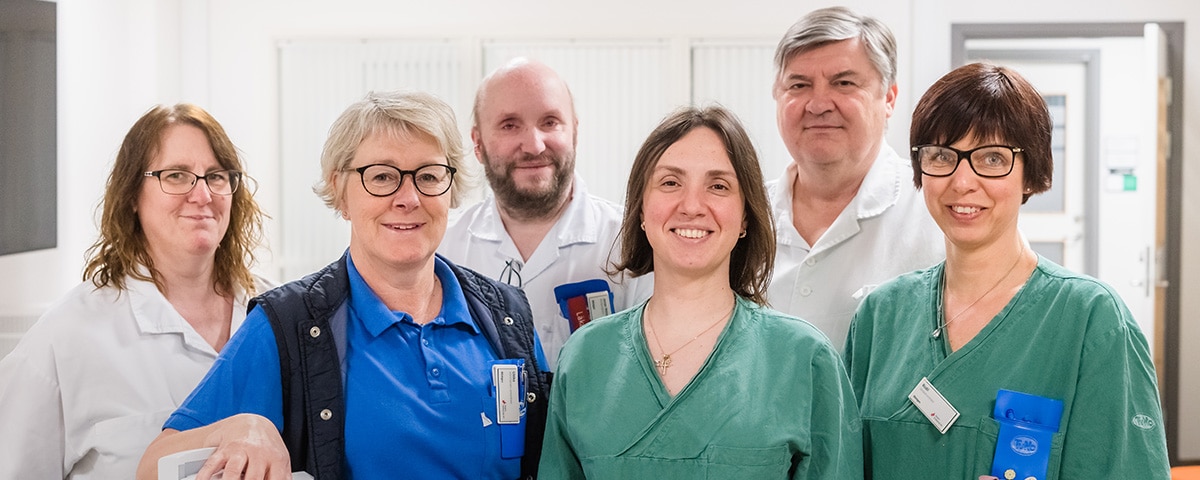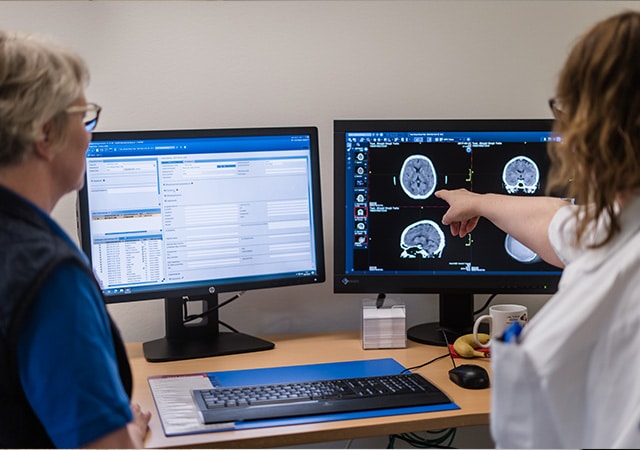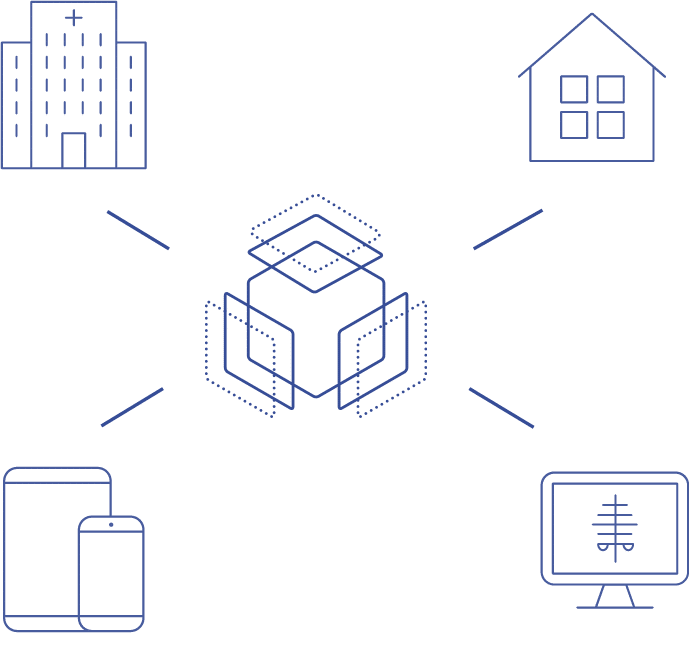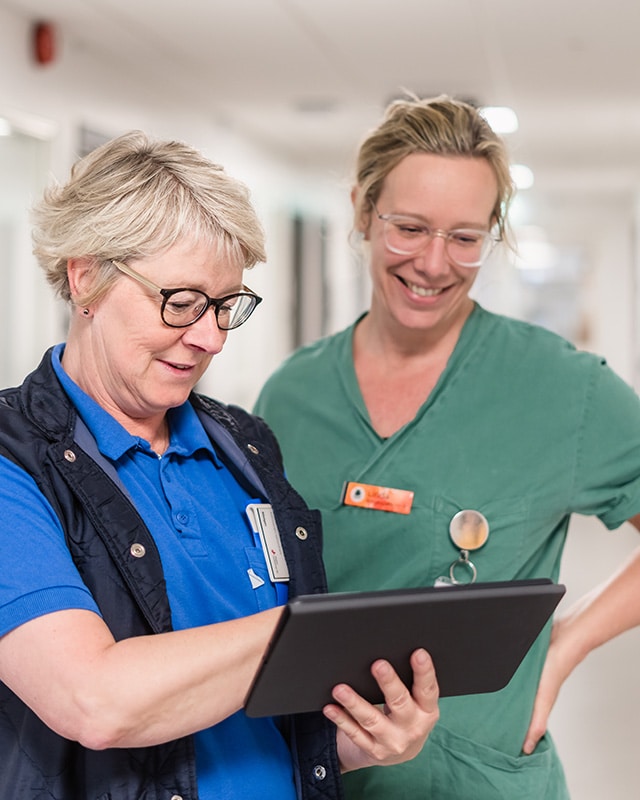Customer Case Study
Jönköping County Region Public Health

For the three hospitals of the Jönköping County Region, Sweden, implementing the unified Enterprise Imaging platform during COVID has been a challenging experience – but one that promises new benefits in productivity, collaboration and efficiency.
A consolidated image platform, across three sites
The Jönköping County Region public health authority is responsible for three of the largest county hospitals in Sweden – Ryhov, Eksjö and Värnamo hospitals – which each provide a broad range of health services. For this long-term AGFA HealthCare PACS customer, transitioning to Enterprise Imaging was an opportunity not only to upgrade to the latest technology, but also to add in new functionalities that enhance its service to the people it cares for.
“We were very satisfied with AGFA HealthCare’s IMPAX PACS, but we knew it was time for a change,” describes Dr. Henriettae Stahlbrandt, radiologist and head of the project steering committee for Jönköping County Region. “We had been talking about an upgrade for several years, and Enterprise Imaging offered the latest technology and possibilities, including compatibility with Microsoft Windows 10.” It also gave the region the opportunity to add some much-needed new capabilities.

“Altogether, the new platform and tightly integrated functionalities give the hospitals the complete and unified workflow they need: from order to scheduling and order evaluation, through to reading and report distribution.”

Radiologist and head of the project steering committee
for Jönköping County Region
Advanced features for radiologists and referrers
In the months since the go-live, the hospitals have already experienced improvements, and Dr. Stahlbrandt expects more as users get accustomed to working with the new platform. “We see a lot more possibilities. Speaking as a radiologist, I can specifically mention the order evaluation workflow, which makes it easier to check in the system if a patient has any allergies or contraindications. That both speeds up the radiologist’s workflow and enhances patient safety.
“Dragging and dropping series in the image area is more convenient, and when comparing images, you can put them side by side. Reporting has improved as well: creating the reports is simpler and faster for the radiologists, which accelerates turnaround time. But also, using the report sections, the clinicians and referrers can more easily find the critical information they need within the report. Furthermore, the referrers can view the report with the images right in their EHR, while patients can read their reports via the patient portal.”
Communication and collaboration will also be enhanced, she continues: “Individual communication with our peers, clinicians and patients, and also multidisciplinary team meetings are of course an important part of our healthcare approach. But working and collaborating across three separate sites raises some challenges.” Enterprise Imaging’s collaboration tools, including live screen sharing that allows multiple colleagues to see images and annotations in real time, will considerably improve communication across the sites .
“You need a comprehensive timeline early on, and plan for more training and education than you think you will need. Look at the bigger picture first, then plan the details. And use AGFA HealthCare’s experience – they are the ‘pros’, after all.”

As productive working from home as in the hospital
Homeworking is also easier with Enterprise Imaging. “Our radiologists had been having compatibility issues between the PACS and the reading stations when working remotely. And when COVID hit, the problem became even more acute, because we moved to having as many people working from home as possible, including radiologists. Enterprise Imaging solved the compatibility problem, immediately enhancing remote reading.” “The system is also much more stable for remote work: before, remote users would have to reboot their computers a couple of times a day, but that is no longer necessary with Enterprise imaging. Working
from home has become much more comfortable and productive.”

Using insight and analytics to improve patient care
The business intelligence functionality will provide the Jönköping region with the insight it needs to make decisions about capacity and productivity, helping the hospitals provide the service and care patients and referrers need. “Business intelligence will give us data on how many referrals are coming in and the different modalities being used for these, plus how quickly the referrers receive their patients’ results,” Dr. Stahlbrandt begins. “It will also be extremely helpful for complying with the Swedish ‘cancer pathways’ approach, which requires very fast investigation of suspected cancer cases, so the patient gets the diagnosis quickly and can start treatment as soon as possible. The radiology department is a key player in the cancer pathways: we need to ensure proper follow-up and compliance with the agreed waiting times for exams and reports.”
The insight from business intelligence will help to balance workloads, as well, explains Dr. Stahlbrandt. “If we see one of our three hospitals has higher waiting times, we may choose to send a patient to a less busy hospital, where they will be seen more quickly. And we will be able to use this information to know where to concentrate our radiologists, creating a more balanced workload.”
“Business Intelligence will be extremely helpful for complying with the Swedish ‘cancer pathways’ approach. The radiology department is a key player in the cancer pathways: we need to ensure proper follow-up and compliance with the agreed waiting times for exams and reports.”
An ‘intelligent’ future
Another key aspect of Enterprise Imaging for the region is AGFA HealthCare’s approach to integrating artificial intelligence. “Our artificial intelligence strategy was postponed due to COVID, but will go forward. We will work only with our current major vendor partners – and for radiology, one will be AGFA HealthCare and Enterprise Imaging.
“We are looking into artificial intelligence tools for interpretation and diagnosis, for example of lung patterns in a CT scan.” AGFA HealthCare’s own strategy for artificial intelligence is based on a ‘best-of-breed’ approach using third-party algorithms, fully embedded into the Enterprise Imaging workflow as complete bundles. “We appreciate that AGFA HealthCare carefully selects the most useful algorithms. Furthermore, having the algorithms integrated in the Enterprise Imaging platform is vital: we would not consider any other option at this point,” says Dr. Stahlbrandt.
“Having the artificial intelligence algorithms integrated in the Enterprise Imaging platform is vital: we would not consider any other option at this point.”

The journey continues after the ‘go-live’
While the implementation of a multi-site Enterprise Imaging platform always requires thorough organization and project management, installation during the COVID pandemic created additional challenges, for the hospitals and for AGFA HealthCare. “There were several delays, and the reduced in-person contact impacted training in particular, but the go-live went quite well. It took place over a weekend and was well organized. And we are organizing follow-up training to address the gaps there.”
Looking back at the experience, managing expectations is critical, says Dr. Stahlbrandt. “You need a comprehensive timeline early on, with what to expect, issues to think about, how to prepare, etc. And definitely, plan for more training and education than you think you will need. Look at the bigger picture first, then focus on the details. Finally, use AGFA HealthCare’s experience – they are the ‘pros’, after all.”
“This has been a challenging project for us, and we still have a way to go – follow-up after the go-live is very important! However, the dedication, support and collaboration from the AGFA HealthCare team have been very strong. That relationship is critical to a successful implementation of Enterprise Imaging,” she concludes.
“The support and collaboration from AGFA HealthCare have been very strong. That relationship is critical to a successful implementation of Enterprise Imaging.”
Dr. Henriettae Stahlbrandt
Radiologist and head of the project steering committee for Jönköping County Region
AGFA HealthCare’s solution
Enterprise Imaging for Radiology is a consolidated image management platform supporting productivity, collaboration and mobility.
Enterprise Imaging automates workflows and eliminates repetitive tasks, so radiologists can focus their efforts and expertise to promote value-added care.
Images and imaging data can be viewed and shared, in real time, within and across departments and sites.
Radiologists can work as comfortably and productively at home as at the hospital, with the same user experience.
The tight integration of Enterprise Imaging with the scheduling functionality creates a complete workflow: from order to booking and order evaluation, to reading and report distribution.
The XERO® Universal Viewer makes relevant multimedia content accessible anywhere, anytime, and provides a rich collaboration toolset.
Business intelligence analytics and tools support the hospital’s goals to increase productivity and optimize resources.
